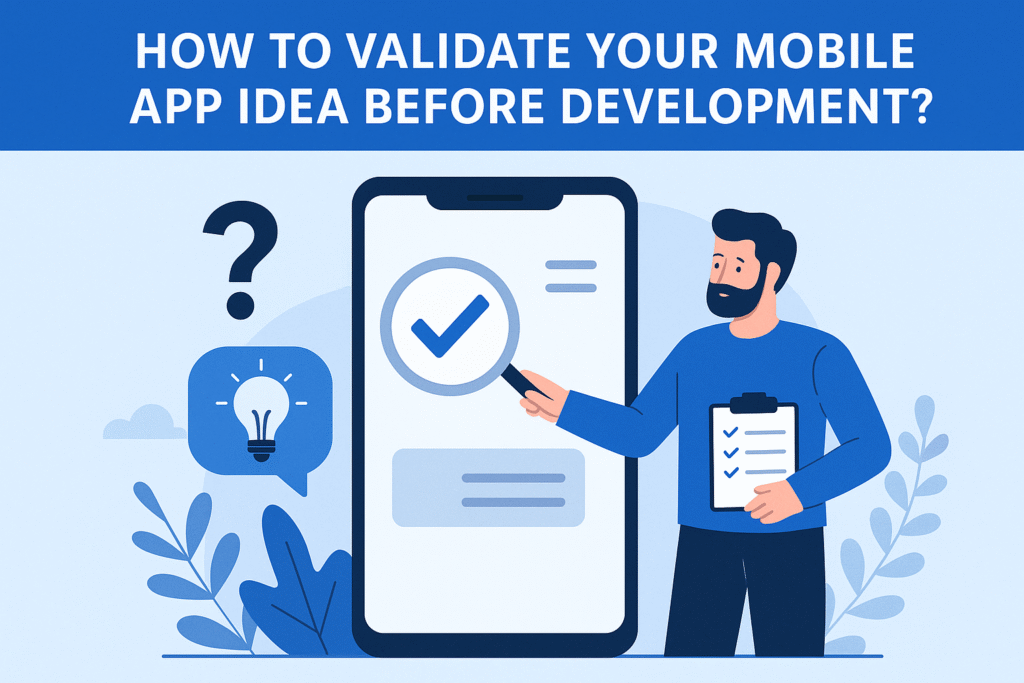How to Validate Your Mobile App Idea Before Development?
Having a brilliant app idea is great! But you can’t just jump into building it without validating your mobile app. Yes, validating your mobile app idea will help you understand real market need, save you from wasting time, money, and energy on something that might not succeed.
Before investing in design or development, it is important to first carefully research and test your app idea to ensure it’s truly viable. For this, many businesses rely on expert app development services to guide them through this critical early stage and avoid costly missteps.
In this guide, we will explore the essential steps to validate your mobile app idea and ensure that you launch something that people genuinely need.
1. Define the Problem Clearly
Every great app starts by solving a meaningful problem. First, you will clearly identify the specific issue you aim to address and who is affected by it. If the issue is vague or only matters to a tiny audience, you may need to refine your idea. Define your target users and make sure that the problems they face are genuine, recurring, and deeply impactful.
2. Conduct Market Research
Now that you have defined the problem, it is time you explore the competitive landscape. Analyze other apps and see how they solve similar problems. Take a close look at their features, ratings, user feedback, and business strategies. Identify the areas they are lacking and where they are best excelling.
You can use tools like:
- App Store & Play Store for user reviews
- Google Trends for keyword interest
- SimilarWeb or SensorTower for app performance insight
If you find users complaining about a specific feature, that might be your opportunity to do better.
At this stage, many startups team up with an iPhone app development company to refine their ideas using expert insights and a proven launch experience.
3. Create a Minimum Viable Product
Before building a full MVP (Minimum Viable Product), it is always wise to start with a Minimum Viable Concept (MVC). This could be as simple as:
- Wireframes or mockups
- A clickable prototype
- A landing page explaining the idea
- An explainer videos
Your aim is to attract potential users by showcasing the main benefit of your app in a clear format. This will help you collect feedback before fully investing in development.
Try using tools like Figma, InVision, or Marvel to make simple, clickable versions of your app.
4. Validate with Real Users
When you have real-world feedback, it becomes a powerful tool for shaping your product into something users truly want. Share your concept with your target audience—through social media, email lists, communities, or even in-person interviews.
Ask potential users:
- Would you use this app?
- What features are most important to you?
- What would make you stop using it?
Furthermore, you can also plan to run small ad campaigns on platforms like Google or Instagram to attract visitors to your landing page.
5. Test the Monetization Strategy
An ideal app also seeks to balance user value with business sustainability. Whether your app is free, subscription-based, or ad-supported, ensure you choose a model that aligns with your users’ needs and expectations while supporting long-term growth. You can also conduct surveys or A/B tests to see what users would be willing to pay (if anything) and what pricing model works best.
Even if making money isn’t your primary goal, knowing your app’s value and what users are willing to give in return can help build a product that can grow and succeed over time.
6. Analyze and Iterate
Validation never ends- it is a continuous process of learning, adjusting, and improving. As soon as your app receives feedback from real users, it is time to analyze patterns and iterate on your ideas. In case you find users expressing confusion about the same feature or suggesting the same enhancement, it is a sign to make meaningful changes that address recurring concerns.
Final Thoughts
Validating your mobile app has become a necessary step in building and delivering a product that resonates with users and makes an impactful difference in the market. Many promising apps fail as they were built before confirming demand. By clearly identifying the problem, studying what others are doing, creating early versions of your app, testing them with real users, and learning from their feedback- you can set a strong foundation for a successful launch.
When you are all prepared to move from idea to execution, partnering with experienced leaders can make all the difference. A android app services provider can help you bring your validated concept into a fully functional product with their expertise in design, development, and deployment.


